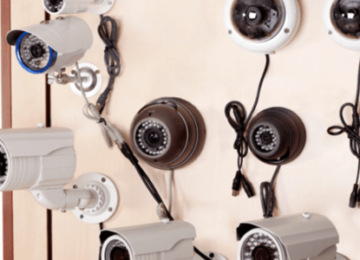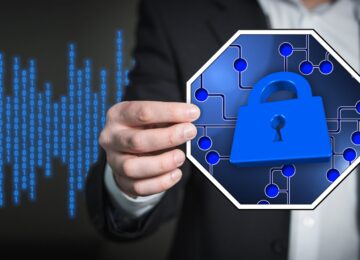Deep learning and its applications in video surveillance

Security is a major concern for everyone in our society, in both the public and private sectors. The deep learning revolution in artificial intelligence is providing remarkably effective solutions in the video surveillance sector. By offering better analysis of the data captured by cameras, this advanced technology has unrivalled real-time detection and recognition capabilities. Find out how this branch of AI is revolutionising video surveillance and improving the protection of people and property, particularly for retailers.
History of Deep Learning
Deep learning is a sub-field of artificial intelligence. Historically, the first attempt to reproduce the functioning of a human brain in the IT sector dates back to 1943, and the first neural network, the single-layer perceptron, appeared in 1957.
The aim of Frank Rosenblatt, the American psychologist who developed this model, was to enable a computer to learn from new data and an algorithm that analysed it: this was machine learning. Then came the multilayer perceptron in the 1980s, in which neurons are divided into several connected layers, followed by convolutional neural networks developed to process images.
To understand this better, let's take the example of a programme whose function is to recognise a cat. We start by feeding the machine images of cats, which it then uses to identify the animal in new images by machine learning and comparison.
If we want to go further, we'll use the deep learning process. This works in layers: thousands of neurons perform calculations (angles, lines) at a first level, then these serve as the basis for other combinations and calculations at a second level, etc., until a very fine, relevant result is obtained. As a result, the greater the number of layers, the more convincing the result.
Deep learning has been around since the 1980s, but it is particularly popular today. This is because computer power has increased steadily over the years, as have data volumes, opening up a whole new world of possibilities. For example, deep learning is booming in the fields of transport, medicine, robotics and security.
Applications of deep learning in the field of security
Security professionals are keeping a close eye on technological advances, particularly deep learning, to improve their systems. Expectations in this field are very high these days, as customers - be they private individuals, retailers or public bodies - are keen to combat the increase in theft andensure the safety of individuals as effectively as possible.
As a result, video surveillance and video protection cameras, as well as other devices such as on-board cameras and drones, are incorporating new functionalities based on deep learning.
Vehicle identification
Deep learning can also be used to identify vehicles, and in particular their number plates, a functionality that is much in demand in traffic flow management (entry and exit, road traffic), road safety and the detection of offences (suspect vehicles, vehicles without number plates, vehicles not travelling in the right lane, etc.). This tool can also be used to manage parking spaces in a town or car park area.
Object detection
The detection of objects by artificial intelligence has many uses. Autonomous car systems, for example, need to be able to identify vehicles and obstacles of all kinds in order to ensure that driving goes smoothly and to be able to react in the event of an accident. Deep learning is a major asset because, unlike machine learning, it offers greater speed and better performance.
Object detection is also beneficial to businesses, particularly in warehouses and shops, to detect missing items or monitor their movements.
Counting customer flows
In addition, the training of deep learning networks linked to specific software leads to automatic and intelligent counting capabilities. This saves an enormous amount of time and is much more efficient than manual counting or counting through portals. Video surveillance cameras can therefore have a dual function by producing statistics or forecasting human or road traffic, for example.
As well as the security aspect, they can be useful to marketing departments and company directors. They can be used to find out whether a communication campaign has been successful, whether it is necessary to close or open a shop at a particular time, whether employees' working hours need to be reorganised or even recruited, or whether product displays are efficient. They can also provide a predictive analysis of customer behaviour.
Deep learning: a must for video surveillance in retail outlets
The new intelligent functions also make the work of retailers, managers and security guards easier. Shoplifting is exploding in all types of shops: supermarkets, pharmacies, grocers, cosmetics shops, clothing stores and all kinds of other products.
Because of inflation, most establishments have noticed this trend and the fact that it affects all populations: from minors to the elderly. There is no typical profile among shoplifters. That's why the demand for effective video surveillance is so strong. It helps to reduce shrinkage while complying with the strict rules of use dictated by the law.
The algorithms on which retail security software such as Veesion is based use both machine learning and deep learning to :
- Detect suspicious gestures: Moving items in pockets, sleeves, motorbike helmets, pushchairs, etc.
- Track product movements: detect the removal of large quantities of items from shelves
- Reduce false alarms: Safety devices based on deep learning learn from their mistakes. By feeding back these errors, they modify their analysis so that they don't make the same mistake again.
While deep learning is the result of complex work and produces results that are just as complex, it is also extremely easy to learn. Veesion, for example, can be implemented using existing security systems. What's more, alerts can easily be received on the security manager's smartphone or tablet, while taking into account the needs and specific features of each company.
In addition, video surveillance is highly regulated by law. The use of deep learning for in-store security must meet the challenges of data protection. For example, the recognition of individuals and the recording of customers are prohibited. In addition, the technology in question must not be used to monitor the work of employees. Finally, the devices do not make any decisions: it is always the human being who makes the final judgement. This is the basis on which our Veesion software works.
In conclusion, deep learning opens up new horizons thanks to its computing power and its advanced analysis of video surveillance images. Complex situations are processed in real time, enabling an immediate response to an incident. The applications go beyond simple surveillance, contributing in parallel to personal safety, the organisation of spaces and even marketing campaigns. Deep learning is therefore a technological development that cannot be ignored today in the way we approach and manage security.
The most popular
Related news
Discover what Veesion can do for you. Do you have one or more stores?
Our team will contact you within 48 hours





